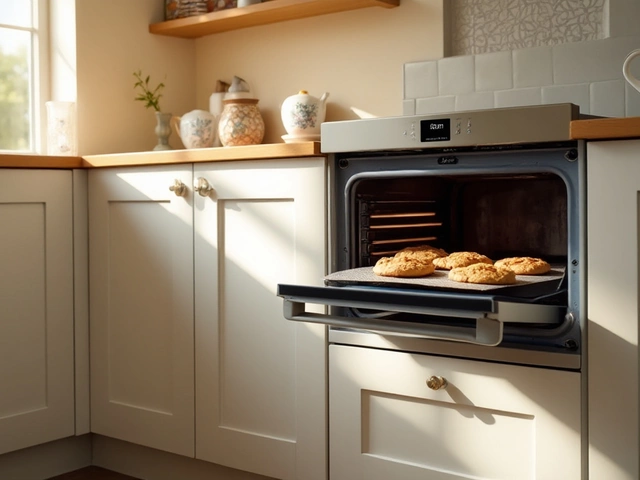Picture this: You pop a pizza in the oven, set the temperature, and nothing happens. Absolute silence. No heat, no light, that familiar burn smell nowhere to be found. That's when the big question hits—do you get the cooker repaired, or would you be better off sending it to appliance heaven and shelling out for a brand-new one?
It’s never just a matter of money alone. There’s time, hassle, the heartbreak over your trusty old cooker, the irksome eco-guilt of chucking out something that might've had years left. And let’s not ignore that replacements can mean a string of extra costs—taking out the old one, fitting the new one, sorting out any electrical or gas issues. None of it sounds fun, does it?
You wouldn’t believe this, but cookers are among the top ten most repaired kitchen appliances in the UK. And with the average cooker lifespan sitting at 13 years (that’s older than most household pets), it’s no shock that repairs crop up more often than you’d like. So—should you save your cooker or move on? Let's break it all down and make that dreaded decision a bit easier.
The True Cost of Cooker Repairs vs Replacement
First thing you probably want to know: what’s it going to cost me? Going straight to the numbers, typical cooker repairs in the UK range from £50 to £200, depending on the fault. Common repairs like swapping out a heating element or fixing a broken thermostat often fall right in the middle—think £80 to £120 for parts and labour, unless you’re unlucky enough to need a new control board or glass top, which can send you closer to the upper end.
Now, if you’ve got a fancier model—maybe an induction hob with all those bells and whistles—parts get pricier fast. Some brands only work with their own engineers, meaning higher callout and diagnostic fees, too. When it comes to ovens built into fancy kitchens or specialist gas cookers, costs soar again because you'll probably want a qualified Gas Safe or NICEIC-registered professional, and these folks don’t come cheap. Think £100+ just for a callout and diagnosis on top of whatever fixes are needed.
How about the replacement side? A decent new cooker will set you back a minimum of £350-£500, and that’s before delivery, installation, and removal of your old appliance enter the picture. Installation itself typically runs around £70-£150, but things can unravel fast if there are upgrades needed to your gas supply or electrics. Those sorts of surprises land on a lot of people, with some ending up paying £700 or more all-in for a solid mid-range cooker swap.
There’s also the hidden cost of time. Booking an engineer, waiting for the part to come, or measuring your worktop for a new appliance—none of that happens instantly. If you’re cooking for a big family or simply rely on your oven every day, you might need a backup plan (hello, takeaway!) while you sort it all out—a cost most people forget to factor in.
So where’s the break-even? A lot of engineers and repair experts stick to a rule of thumb—if the cooker repair costs over 50% of a comparable new appliance, replacement starts to look like the sane choice. That said, a repair under £120 usually makes sense economically, particularly if your cooker isn’t on its last legs (more on that below).
There’s another overlooked cost: the environment. Around 100,000 tonnes of electrical appliances—including cookers—end up in UK landfill every year. Fixing your cooker when possible cuts your carbon footprint, keeps waste down, and feels a whole lot better than dumping a perfectly repairable gadget.

When Fixing Your Cooker Is Worthwhile
So, does it ever really make sense to call the repairman instead of shopping for a new cooker? Honestly, yes—plenty of times. If your cooker is less than six years old, odds are it’s got years left in it (barring a total manufacturing dud). Even simple issues like a worn oven door seal or broken knob can cause cooking chaos, but are usually cheap to sort out. Door seals, for instance, run a tenner or two and you can fit them yourself in ten minutes—no need for specialist help.
The most common faults that make people hit search engines for ‘cooker repair near me’ are broken elements, blown fuses, dodgy thermostats, faulty ignitions, and issues with the digital display. For a lot of those, parts are readily available even for cookers over a decade old. Replacing an oven element is so common there are video tutorials everywhere. If you can use a screwdriver without hurting yourself and you switch off the main power, you can probably handle it yourself (but don’t mess with gas).
One surprising fact: almost two-thirds of electric cooker breakdowns are caused by poor cleaning and build-up of food debris, so a proper clean can sometimes ‘fix’ a lot of problems. Burners not heating evenly? Check for baked-on grime or warped pans before you call the pros.
What if the repair sounds more complicated? If your cooker has a good track record otherwise—heats up fast, solid build, no cracks or interior rust, decent energy rating—then fixing issues like a fan motor or control knob can squeeze at least a few extra years out of it for far less than a new model. But don’t fall into the ‘just one more fix’ trap with appliances older than 12 or 13 years unless it’s a simple (and cheap) part swap.
Brand reputation matters a lot. Models from brands like Bosch, Hotpoint, Beko, and Neff tend to have better spare part availability and often cost less to fix. Quirkier brands, or weird imports, might leave you struggling to source the right parts—this is where repairs get tricky or sometimes impossible, unless you want to pay to ship parts from overseas and wait weeks.
Warranties can also tip the balance. Cookers under five years old sometimes have extended warranty schemes—some are transferable to new owners, so it’s worth checking paperwork before you do anything. Even if your warranty is expired, some manufacturers run fixed-fee repair programs (think £120-£150 flat for diagnosis, parts, and labour) for common faults. Well worth asking about it.
Here’s a quick checklist to decide if repairing your cooker makes sense:
- Repair cost is under 50% of replacing with a similar new model
- Your cooker is under 10 years old
- Parts are easily available and not special order from abroad
- The cooker has had few or no major problems before
- No major structural or safety faults (no gas leaks, big cracks, or burning smells)

When Replacing Your Cooker Is the Smarter Option
Not every repair is worth the effort. If your cooker is pushing 13 years old or more, chances are the next thing to break is right around the corner. Constant repairs become a money pit, and soon you’re chasing fault after fault. Especially with older cookers, some fixes just aren’t possible anymore—parts get discontinued or the workarounds become fiddly, unreliable, or unsafe.
Think about safety, too. If you’re seeing sparks, smelling burning plastic, or noticing exposed wires, power surges, or anything to do with gas leaks or carbon monoxide alarms—stop using the cooker and bin it. Even if someone offers to ‘fix’ it, you’re rolling the dice with your safety. These sorts of major faults are classic signs the appliance has run its course.
Tech upgrades are a big reason people switch. New cookers have way more energy-efficient elements, better control panels, timer functions, and features like catalytic liners that actually clean themselves (dreamy, right?). If your electric bills have been sneaking up and you’re still using an ancient cooker with a G energy rating, replacing could save you £45-£80 a year—nothing crazy, but it adds up if you use your oven a lot.
Sometimes replacement is forced on you. If the oven cavity is rusty, the door is warped, or the touch panel is peeling off, it’s not just about looks. Warped parts make the oven inefficient or flat-out dangerous—a new door can cost you £200+ for some cookers, and that money’s better spent elsewhere.
Don’t forget the lifestyle factor. Maybe you need a double oven, want faster induction cooking, or the kids outgrew the old model’s capacity. Kitchen refits are a handy time to upgrade since you’ll have installers in anyway and might snag a deal on a replacement as part of a package. On the other hand, don’t rush to buy a new cooker based on a cosmetic fault—replacement glass panels, knobs, and bulbs are usually a quick fix and well worth trying before going big.
There’s a little-known scheme in Bristol and a lot of other UK areas: council collection and recycling services sometimes offer a removal discount if you’re upgrading to a more energy-efficient cooker. Worth a phone call to your council’s recycling helpline—you might save a bit on disposal fees.
One thing people rarely do (but should): read reviews of new cookers before you take the plunge. Some stylish models look great but have shocking track records for reliability. Trust the boring bestsellers—there’s a reason the same sturdy designs get recommended by repair pros again and again.
So: if your cooker keeps failing, costs as much to repair as to buy anew, is missing key safety features, or doesn’t match your needs anymore, it’s probably time to say goodbye. Still, don’t get caught out by sales tactics. Retailers love to convince you ‘it’s not worth it—just buy new!’ When in doubt, get a repair quote first and weigh your options carefully.




